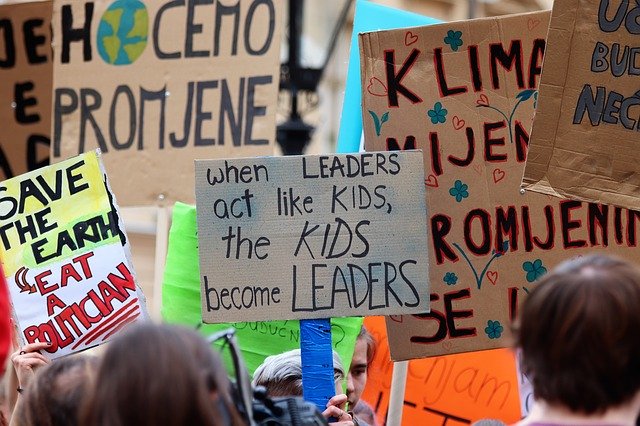“Climate Strike” is officially the word of the year—with rewilding, bopo (short for body positivity) and hopepunk as runners up.
Every year, Collins Dictionary carefully analyses prominent terminology, and measures whether or not these words are being used significantly more in media and public discourse than the previous year. In 2019, the term “climate strike” was used an average of 100 times more than it was in 2018—a sign that the hundreds of thousands of student activists who followed sixteen year old Greta Thunberg’s lead in skipping school to protest for meaningful action on the climate crisis are striking a chord.
What are these movements—and why are some of them gaining more attention in the media than others? By now, you have most likely heard of Extinction Rebellion, the youth-lead movement of activists who risk arrest by gluing themselves to buildings and trains across the United Kingdom in order to bring the drama of climate change to the public eye. Naturally, the media has taken their bait—hook, line and sinker; Extinction Rebellion’s dramatic actions, bold statements and theatrical performances frequently make the front pages, and their name has become synonymous with the climate movement.

But what about the less popular movements—those protesting the same crisis, but without the fanfare. Why don’t we hear as much about them? In August of this year, tens of thousands of indigenous women and girls from over 110 ethnic groups in Brazil took to the streets of Brasília to protest how Bolsonaro’s destructive policies impact the Amazon rainforest, and how women are disproportionality impacted.
“Women from the Amazon have been echoing a strong urge to act against fast-tracked consumerist needs that do not respect our lands, our culture, our rights,” one activist at the march shared.
“The government approves huge business endeavours such as the installation of several hydroelectric stations in the Amazon basin. We – women and girls – are occupying spaces where they want to build, and denounce their illegal mining which is toxifying our bodies with mercury.”
She was one of many representing communities directly affected by the catastrophic Amazon forest fires, marching for their voices to be heard in public policy, and decision making. Yet, her message was not nearly as global as that of Extinction Rebellion, as the movement received little to no media coverage.
She wasn’t the only one. In the United States, sixteen year old Jamie Margolin is organizing the Zero Hour movement, an effort to work directly with communities most impacted by climate change.
“Those closest to the problem are also often closest to the solution,” he writes in their mission statement. “These communities have been actively working to create just solutions and transitions. Our goal is to centre the unique wisdom, experience, and leadership of these communities in our efforts to make impactful change.”
Unlike Extinction Rebellion, which was often criticized for having a non-inclusive platform which prioritized getting arrested over addressing how climate change is impacting communities of color, the Zero Hour movement focuses on getting to the root of what causes a climate crisis, educating communities across the Untied States about how colonialism, capitalism, racism and sexism have created environmental injustice. However, compared to its British counterpart, this movement barely made the media.
Of course, we cannot talk about the climate change movement as it is today without talking about Greta Thunberg. The 16-year-old Swedish activist first commanded attention by protesting outside the Swedish parliament, calling for immediate action against climate change, inspiring over four million others to take part in the global climate strikes. While often thought of as the face of the climate change movement (and vilified as such), it is important to remember that she is part of a much wider network of inspiring young people fighting climate change, many of whom have been working on these issues long before they commanded international attention.
One of these extraordinary young people is twelve-year-old Amariyanna “Mari” Copeny, who started her activism in 2016 by writing to Barack Obama about the dire water situation in her hometown of Flint, Michigan.
“Flint is not unique,” she wrote. “There are dozens of Flints across the country. Cases of environmental racism are on the rise and disproportionately affect communities of people of color and indigenous communities.”
A young Mexican woman named Xiye Bastida from San Pedro Tultepec which was regularly affected by heavy rainfall and flooding that swept the area where she grew up. Many years later, she now protests at the United Nations every Friday, fighting to ensure that an indigenous perspective is always present in climate change conversation. As she says, “the first ones to get affected are Indigenous communities who are displaced because of infrastructure and disrespect of the land.”
This is just a small sample of the countless other inspiring young climate change activists and movements that we could outline here. Each one has a unique perspective and approach to the pressing issue, and each of their voices needs to be heard in this conversation. But why is the media covering some extensively while ignoring others? On the ground, activists know that it is only through collaboration between communities that we will be able to fight climate change.
As journalists, we need to take a page from their book. Sure, cover Extinction Rebellion and Greta Thunberg, but also cover the protests in Brazil and Hawaii and the activists in Native American and Indigenous communities. Only by giving a range of activists and movements a space to broadcast their message to the world will we be able to do our job to share ideas and foster the public debate that is needed to create change.